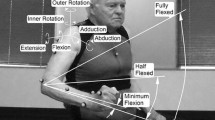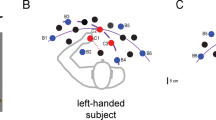Abstract.
This study provides a detailed analysis of disturbances in the kinematics and dynamics of the acceleration phase of multijoint arm movements in six patients with chronic hemiparesis. Movements of the dominant and nondominant limbs were also examined in three control subjects. Subjects performed rapid movements from a central starting point to 16 targets located equidistantly around the circumference of a circle. Support of the upper limb was provided by an air-bearing apparatus, which allowed very low friction movements in the horizontal plane. We found that patients retained the capacity to modulate, in response to target direction, the initial direction of movements performed with the paretic limb. However, in comparison to the nonparetic limb or control subjects, movements of the paretic limb were misdirected systematically. An inverse dynamics analysis revealed an abnormal spatial tuning of the muscle torque at the elbow used to initiate movements of the paretic limb. Based on electromyographic recordings, similar spatial abnormalities were also apparent in the initial activations of elbow muscles. We argue that these spatial abnormalities result from a systematic disturbance in the control signal to limb muscles that cannot be attributed to previously identified mechanisms such as weakness, spasticity mediated restraint, or stereotypic muscle activation patterns (muscle synergies). Instead, our analysis of movement dynamics and simulation studies demonstrate that the spatial abnormalities are consistent with an impaired feedforward control of the passive interaction torques which arise during multijoint movements. This impaired control is hypothesized to reflect a degradation of the internal representation of limb dynamics that occurs either as a primary consequence of brain injury or secondary to disuse.
Similar content being viewed by others
Author information
Authors and Affiliations
Additional information
Electronic Publication
Rights and permissions
About this article
Cite this article
Beer, R., Dewald, J. & Rymer, W. Deficits in the coordination of multijoint arm movements in patients with hemiparesis: evidence for disturbed control of limb dynamics. Exp Brain Res 131, 305–319 (2000). https://doi.org/10.1007/s002219900275
Received:
Accepted:
Issue Date:
DOI: https://doi.org/10.1007/s002219900275




